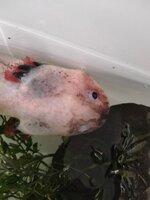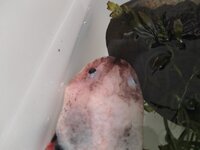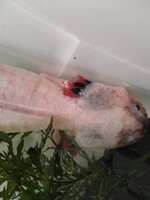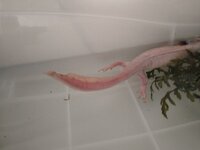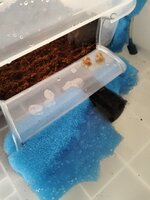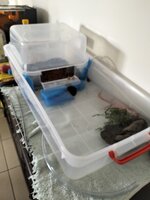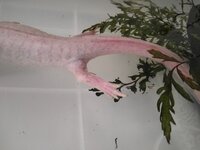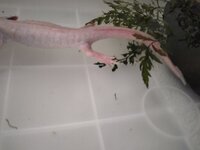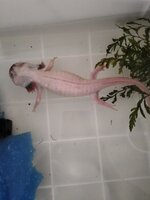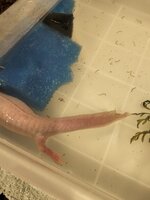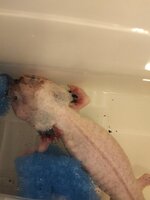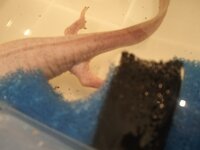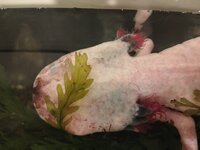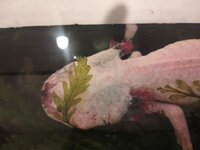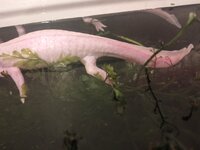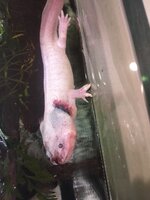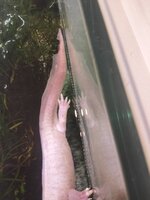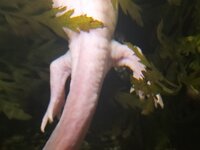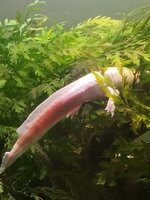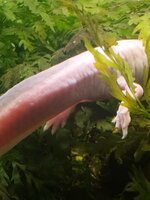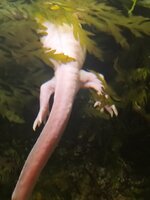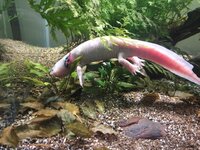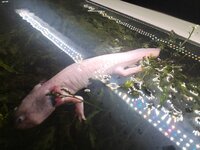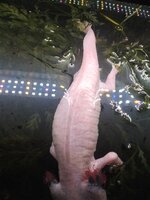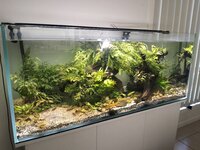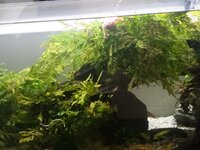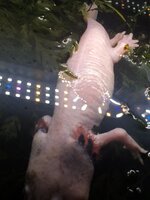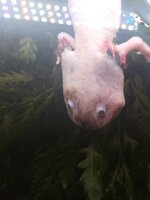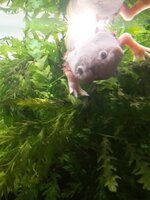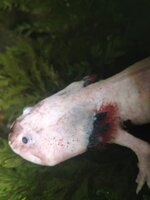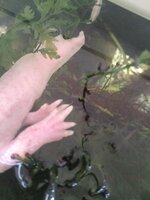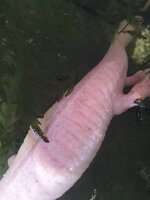Sunnycoastcroc
New member
Hi
I know this is very rare but believe I have one. I'll try explain.
I have kept a wild type for 2.5 years that is very healthy and happy in a chilled and mature 4 foot aquarium with a labrenth of big driftwood and stone caves. There is a lot of ferns throughout the caves and on the drift wood, crypts on the floor
New axy
History, unknown
While at the pet shop, a small family business with reptiles, fish and birds. They do keep a lot of rescue reptiles and occasionally axys. My partner found a large 27cm axy I'd guess that's 10-11". He appeared to be to me just not very well kept. He seemed a bit under weight and what I thought was gills that potentially had been kept in a tank with no chiller or lack of water changes, they were stubby but still fluffy. The pet shop told me he had been eating frozen food and blood worms. My Mrs was not leaving without it. They made sure we had a good home for him before the sale. I watched him for a while as I did not have a quarantine tank. He was active and spending time on the bottom as well as a bit of a swim, not a scared bolt. He had been bitten on the tail so had been put alone in a cool tank, 20c (68f) the wound was healing and not exposed with no sign of nasty. I looked him over for fungus and hook worms but he was clean. Mrs would not leave without him and we thought in our tank he would fatten up and grow the gills out fairly quickly.
We have had him a week
Observations
Straight up I noticed he had a big head and solid rear legs, I put this down to just being a bit under weight and out of proportion. He was drip acclimated and floated on a clear tub for a few hours, my axy was curiously swimming around the tub and neither seemed stressed, they were introduced and get on fine.
We have had him 1 week
We stared to notice a strange behaviour, there is a large driftwood that almost breaches and has bulbitis growing on top that breaches like a kelp patty. He gets up on the fern and has his head out of the water for extended time. Gills, eyes and even mouth. We were watching this and then he blinked, this has been happening often.
At times he almost appears to basking under the light, I thought maybe it was not used to a cold tank, mine is kept at 17c(62f)
He still goes down but mostly likes to perch on something on the surface or close to the surface. I thought this was odd so stared doing some reading, this lead me down a rabbit hole.
The now known signs started to tick the boxes
New observations
It's eyes are bulging
It has big muscles around the armpits of the hind legs
I hadn't payed too much attention to it's upper dorsal fin, I guess I was concentrating on the bite on the rear end of the tail. So I can only make observations from the last 4 days but now the dorsal fin starts about 1" lower than the hind legs and the underside is minimal.
Over the last few days the dorsal fin seems to be getting less high.
It has the zipper like mark down its spine.
Today I don't think it has left it's perch on the wood spending time both just submerged and half out of the water.
We have not gotten him to eat in the 6 days we have had him. Have offered worms, crickets, native roaches, frozen food, DIY repachy pie, and pellets. I would prefer not to try blood worms.
I think the gill stubs have receded more. And look almost like little triangles or a dog's toenails, there still somewhat fluffy.
My other axy has massive gills.
If it is morphing should I go the tub route or leave it in the mature tank and maybe drop the water another inch so he can get out onto the wood?
If the tub is the best route how far should I let it go before putting him in a dedicated transitioning bin?
I just want to do the right thing.
Salamanders have been banned in Australia for a long time but I'm sure there still would be some around. I haven't entirely ruled out that it could be a Salamander as it's history is unknown.
There is also a known population of smooth newts in the wild near Melbourne.
I have rang a pet shop also in Melbourne that advertised they had morphed axys to see if they could offer advice, they told me they had a had a batch once years ago and that they were already transitioned but couldn't really offer any clear advice other than my observations seemed to pointing to a morphing axy. He told me he had been dealing commercially with axys for over 10 years and had never seen it happen himself. This guy suggested I just lower the water water so it can climb onto the wood if it wants, this way it has clean mature water.
Advice appreciated from you guys
Thanks for listening and I hope there's not touch auto correct
I know this is very rare but believe I have one. I'll try explain.
I have kept a wild type for 2.5 years that is very healthy and happy in a chilled and mature 4 foot aquarium with a labrenth of big driftwood and stone caves. There is a lot of ferns throughout the caves and on the drift wood, crypts on the floor
New axy
History, unknown
While at the pet shop, a small family business with reptiles, fish and birds. They do keep a lot of rescue reptiles and occasionally axys. My partner found a large 27cm axy I'd guess that's 10-11". He appeared to be to me just not very well kept. He seemed a bit under weight and what I thought was gills that potentially had been kept in a tank with no chiller or lack of water changes, they were stubby but still fluffy. The pet shop told me he had been eating frozen food and blood worms. My Mrs was not leaving without it. They made sure we had a good home for him before the sale. I watched him for a while as I did not have a quarantine tank. He was active and spending time on the bottom as well as a bit of a swim, not a scared bolt. He had been bitten on the tail so had been put alone in a cool tank, 20c (68f) the wound was healing and not exposed with no sign of nasty. I looked him over for fungus and hook worms but he was clean. Mrs would not leave without him and we thought in our tank he would fatten up and grow the gills out fairly quickly.
We have had him a week
Observations
Straight up I noticed he had a big head and solid rear legs, I put this down to just being a bit under weight and out of proportion. He was drip acclimated and floated on a clear tub for a few hours, my axy was curiously swimming around the tub and neither seemed stressed, they were introduced and get on fine.
We have had him 1 week
We stared to notice a strange behaviour, there is a large driftwood that almost breaches and has bulbitis growing on top that breaches like a kelp patty. He gets up on the fern and has his head out of the water for extended time. Gills, eyes and even mouth. We were watching this and then he blinked, this has been happening often.
At times he almost appears to basking under the light, I thought maybe it was not used to a cold tank, mine is kept at 17c(62f)
He still goes down but mostly likes to perch on something on the surface or close to the surface. I thought this was odd so stared doing some reading, this lead me down a rabbit hole.
The now known signs started to tick the boxes
New observations
It's eyes are bulging
It has big muscles around the armpits of the hind legs
I hadn't payed too much attention to it's upper dorsal fin, I guess I was concentrating on the bite on the rear end of the tail. So I can only make observations from the last 4 days but now the dorsal fin starts about 1" lower than the hind legs and the underside is minimal.
Over the last few days the dorsal fin seems to be getting less high.
It has the zipper like mark down its spine.
Today I don't think it has left it's perch on the wood spending time both just submerged and half out of the water.
We have not gotten him to eat in the 6 days we have had him. Have offered worms, crickets, native roaches, frozen food, DIY repachy pie, and pellets. I would prefer not to try blood worms.
I think the gill stubs have receded more. And look almost like little triangles or a dog's toenails, there still somewhat fluffy.
My other axy has massive gills.
If it is morphing should I go the tub route or leave it in the mature tank and maybe drop the water another inch so he can get out onto the wood?
If the tub is the best route how far should I let it go before putting him in a dedicated transitioning bin?
I just want to do the right thing.
Salamanders have been banned in Australia for a long time but I'm sure there still would be some around. I haven't entirely ruled out that it could be a Salamander as it's history is unknown.
There is also a known population of smooth newts in the wild near Melbourne.
I have rang a pet shop also in Melbourne that advertised they had morphed axys to see if they could offer advice, they told me they had a had a batch once years ago and that they were already transitioned but couldn't really offer any clear advice other than my observations seemed to pointing to a morphing axy. He told me he had been dealing commercially with axys for over 10 years and had never seen it happen himself. This guy suggested I just lower the water water so it can climb onto the wood if it wants, this way it has clean mature water.
Advice appreciated from you guys
Thanks for listening and I hope there's not touch auto correct

